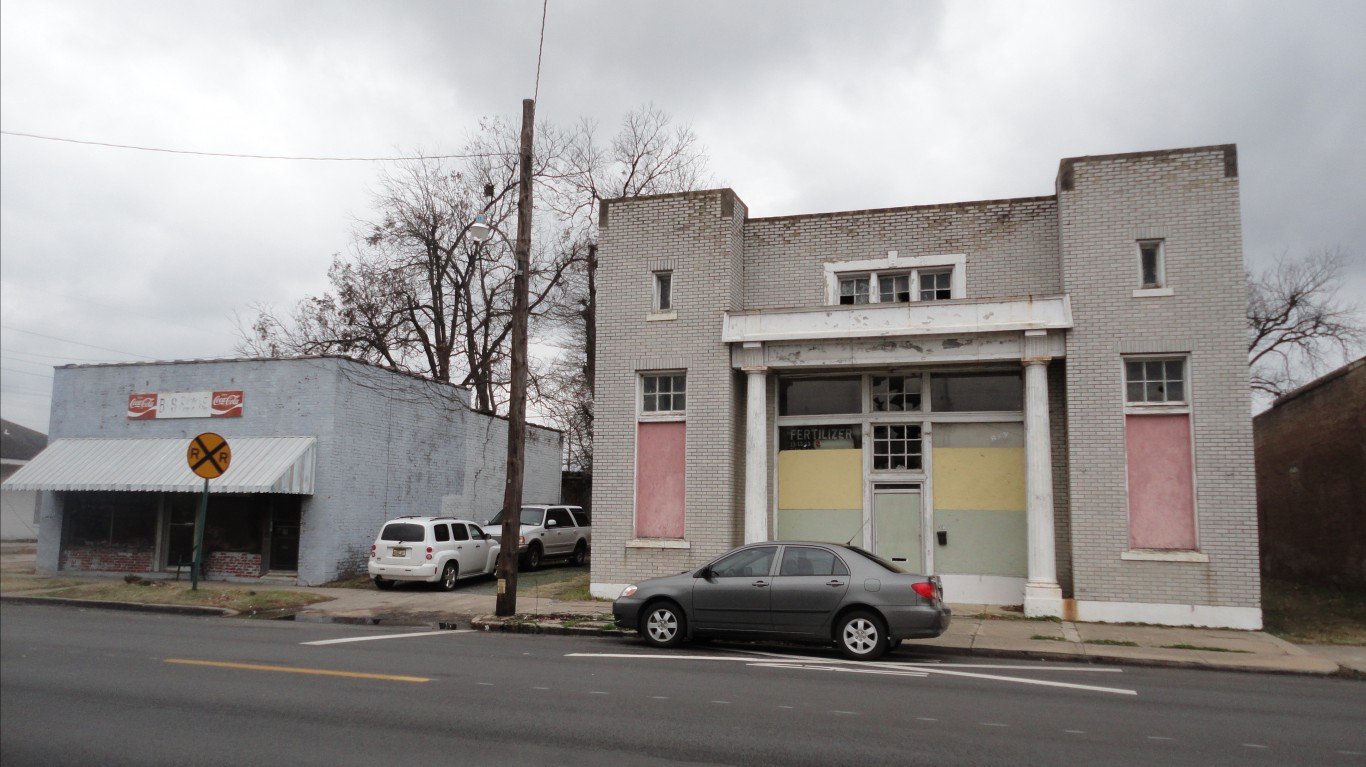

College and university students in the class of 2020 faced the worst — and most uncertain — job market the U.S. had seen in generations. Economic fallout in the wake of the COVID-19 outbreak pushed unemployment to 13.3% in May of 2020, down only slightly from the previous month’s jobless rate of 14.8% — the highest since the Great Depression.
With the average annual cost of a college education ranging from about $26,000 at a four-year public school to $54,000 at a private one, many students take on debt to afford college. Total student debt topped $1.7 trillion in 2020. Considering the financial challenges, it is as important as ever that college graduates secure jobs that require the skills they obtained as undergraduates, and that pay a salary that justifies the investment in their education.
Though the job market has improved significantly since the early months of the pandemic, in some major U.S. cities, recent college graduates still face considerable disadvantages.
Using data from the Bureau of Labor Statistics and U.S. Census Bureau, 24/7 Wall St. created an index of six key measures to identify the worst cities for recent college graduates to find a job. Index measures are related to job growth, financial security, earnings, and employment opportunities for the young and the college educated.
The disadvantages that recent graduates at the beginning of their career face in many of the metro areas on this list vary. One of the most common disadvantages is a lack of employment opportunities in fields that typically require a college degree such as information, finance and insurance, professional, scientific, and technical services. With limited job opportunities in these fields, wages are often lower overall in these areas for workers with a college degree. Here is a look at the lowest paying jobs for college graduates.
With such unfavorable conditions for those with a college degree, it is perhaps not surprising that the metro areas on this list have relatively low educational attainment rates. In the vast majority of these metro areas, the share of adults with a bachelor’s degree or higher is below the 32.1% share nationwide. Here is a look at the least educated city in every state.
Click here to see the worst cities to find a job for recent graduates
Click here to read our detailed methodology
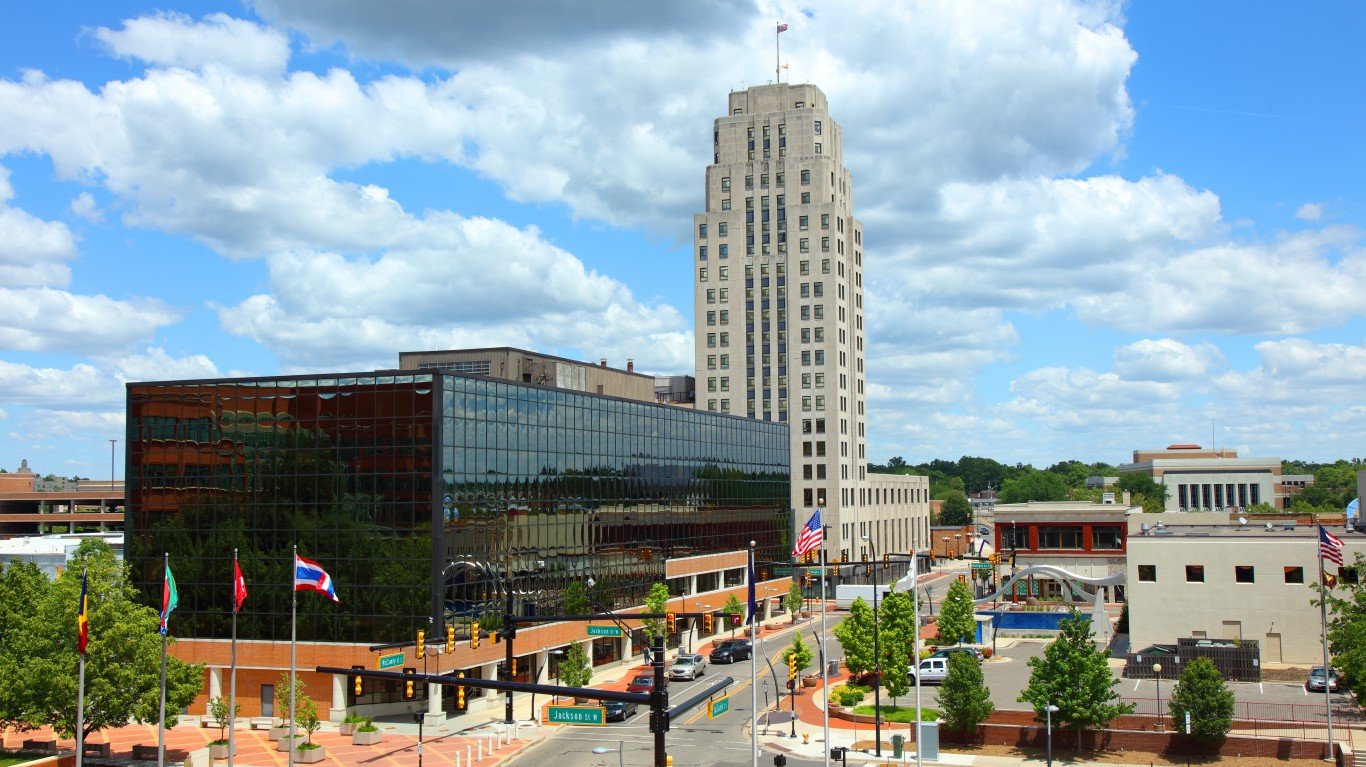
30. Battle Creek, MI
> Fields that typically require a 4-yr. degree: 10.3% of all jobs (middle 50% of US metro areas)
> Avg. monthly wage, 22-24 yr. olds: $2,268 (top 25% of US metro areas)
> Oct. 2021 unemployment: 7.2% (bottom 10% of US metro areas)
> Adults with a bachelor’s degree or higher: 21.0% (bottom 25% of US metro areas)
Michigan’s Battle Creek metro area ranks among the worst places for Americans with a college degree to begin their career. Recent college graduates entering the full-time labor force for the first time face a competitive labor market with limited opportunities in the metro area. Unemployment in Battle Creek was 7.2% as of October 2021, well above the 4.6% national jobless rate that month and higher than about 90% of all U.S. metro areas.
College-educated adults in Battle Creek are also more likely to struggle financially than college-educated workers nationwide. The typical college-educated worker in the metro area earns about $48,000 annually, and 12.0% of college educated residents live below the poverty line. Meanwhile, the median earnings among college graduates nationwide is about $55,000, and only 9.6% of college graduates nationwide live below the poverty line.
[in-text-ad]

29. Orlando-Kissimmee-Sanford, FL
> Fields that typically require a 4-yr. degree: 12.1% of all jobs (middle 50% of US metro areas)
> Avg. monthly wage, 22-24 yr. olds: $2,019 (middle 50% of US metro areas)
> Oct. 2021 unemployment: 4.7% (middle 50% of US metro areas)
> Adults with a bachelor’s degree or higher: 32.2% (middle 50% of US metro areas)
In the Orlando-Kissimmee-Sanford, Florida, metro area, employment opportunities for young adults have declined considerably during the pandemic. Employment among residents ages 22 to 24 has fallen by 21.3% over the past year, nearly the largest decline among U.S. metro areas.
Earnings among college-educated workers in the area are also relatively low. The typical worker in Orlando with a college degree earns just $46,695 a year, well below the national median among workers with a bachelor’s degree of about $55,000.

28. Sumter, SC
> Fields that typically require a 4-yr. degree: 7.2% of all jobs (bottom 10% of US metro areas)
> Avg. monthly wage, 22-24 yr. olds: $1,918 (bottom 25% of US metro areas)
> Oct. 2021 unemployment: 4.3% (middle 50% of US metro areas)
> Adults with a bachelor’s degree or higher: 18.2% (bottom 10% of US metro areas)
Sumter is the only metro area in South Carolina to rank among the worst places for recent college graduates to find a job. Only 7.2% of area jobs are in sectors that typically require a college education — like information, finance and insurance, professional, scientific, and technical services — a smaller share than in over 90% of all U.S. metro areas.
Younger workers also tend to have low wages in the Sumter metro area. The average monthly wage among those in the 22 to 24 age group is only $1,918, less than in over 75% of all U.S. metro areas.
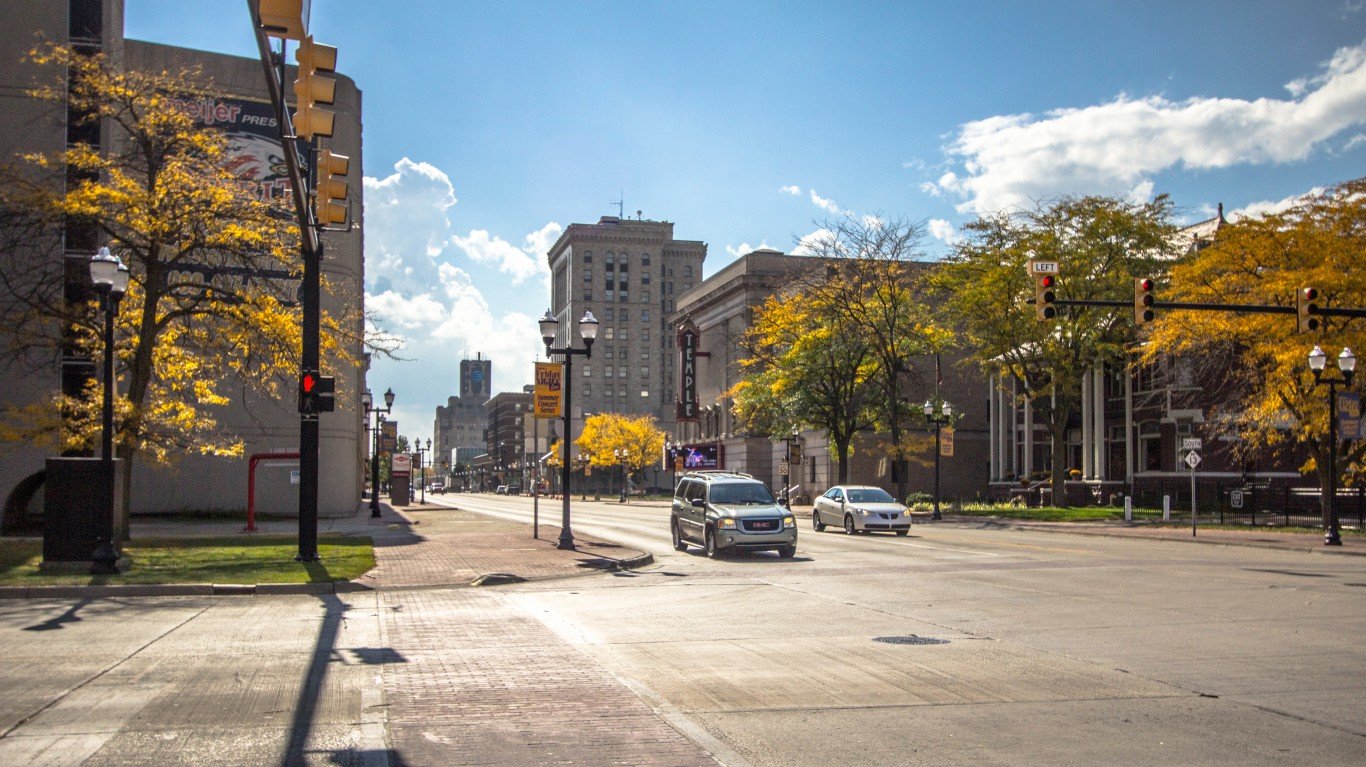
27. Saginaw, MI
> Fields that typically require a 4-yr. degree: 9.3% of all jobs (bottom 25% of US metro areas)
> Avg. monthly wage, 22-24 yr. olds: $1,995 (middle 50% of US metro areas)
> Oct. 2021 unemployment: 7.8% (bottom 10% of US metro areas)
> Adults with a bachelor’s degree or higher: 20.8% (bottom 25% of US metro areas)
The Saginaw, Michigan, metro area has relatively few employment opportunities that are typically suited for those with a bachelor’s or advanced degree. Only 9.3% of all jobs in the metro area are in the information, finance and insurance, professional, scientific, technical, and educational services sectors — less than in over 75% of all U.S. metro areas.
Recent college graduates in the metro area entering the full-time labor force for the first time face a competitive labor market with limited opportunities. The October 2021 unemployment rate in Saginaw stood at 7.8%, well above the 4.6% national jobless rate.
[in-text-ad-2]

26. Shreveport-Bossier City, LA
> Fields that typically require a 4-yr. degree: 10.5% of all jobs (middle 50% of US metro areas)
> Avg. monthly wage, 22-24 yr. olds: $1,826 (bottom 25% of US metro areas)
> Oct. 2021 unemployment: 5.1% (middle 50% of US metro areas)
> Adults with a bachelor’s degree or higher: 23.4% (middle 50% of US metro areas)
Shreveport-Bossier City is one of four Louisiana metro areas to rank among the worst places for recent college graduates to start a career. Disadvantages in the metro areas include the large share of low-wage jobs held by young workers. The average monthly wage for workers between the ages of 22 and 24 in the metro area is just $1,826, less than in over 75% of all other U.S. metro areas.
College-educated metro area residents are also more likely to face serious financial hardship than most Americans with a bachelor’s degree. An estimated 13.8% of local residents ages 25 and up with a bachelor’s degree live below the poverty line, compared to 9.6% of college-educated adults nationwide.
25. Houma-Thibodaux, LA
> Fields that typically require a 4-yr. degree: 9.3% of all jobs (bottom 25% of US metro areas)
> Avg. monthly wage, 22-24 yr. olds: $2,159 (middle 50% of US metro areas)
> Oct. 2021 unemployment: 5.6% (middle 50% of US metro areas)
> Adults with a bachelor’s degree or higher: 16.2% (bottom 10% of US metro areas)
The Houma-Thibodaux metro area in Louisiana is not a desirable place for recent college graduates to look for a job, largely because the types of jobs that typically require a college degree are not especially common in the metro area. Only 9.3% of area jobs are in fields that traditionally require college education like information, finance and insurance, professional, scientific, and technical services, a smaller share than in over 75% of all U.S. metro areas.
A college education also does not confer as large a benefit in earning potential in the metro area as it does nationwide. The typical college-educated worker in the metro area earns just $49,229 a year — only $14,571 more than what the typical area worker with a high school diploma earns. Meanwhile, nationwide, the typical college-educated worker earns nearly $55,000 annually, about $24,000 more than what the typical worker with a high school diploma earns.
[in-text-ad]

24. Brownsville-Harlingen, TX
> Fields that typically require a 4-yr. degree: 10.3% of all jobs (middle 50% of US metro areas)
> Avg. monthly wage, 22-24 yr. olds: $1,617 (bottom 10% of US metro areas)
> Oct. 2021 unemployment: 8.1% (bottom 10% of US metro areas)
> Adults with a bachelor’s degree or higher: 17.3% (bottom 10% of US metro areas)
In Texas’ Brownsville-Harlingen metro area, recent college graduates entering the full-time labor force for the first time face a competitive labor market with limited opportunities. The area’s unemployment rate stood at 8.1% as of October 2021, well above the 4.6% national jobless rate and more than about 90% of all U.S. metro areas.
For young adults who are able to find work in the metro area, most jobs do not pay especially well. The average monthly wage among those in the 22 to 24 age group is only $1,617, less than in over 90% of all U.S. metro areas.
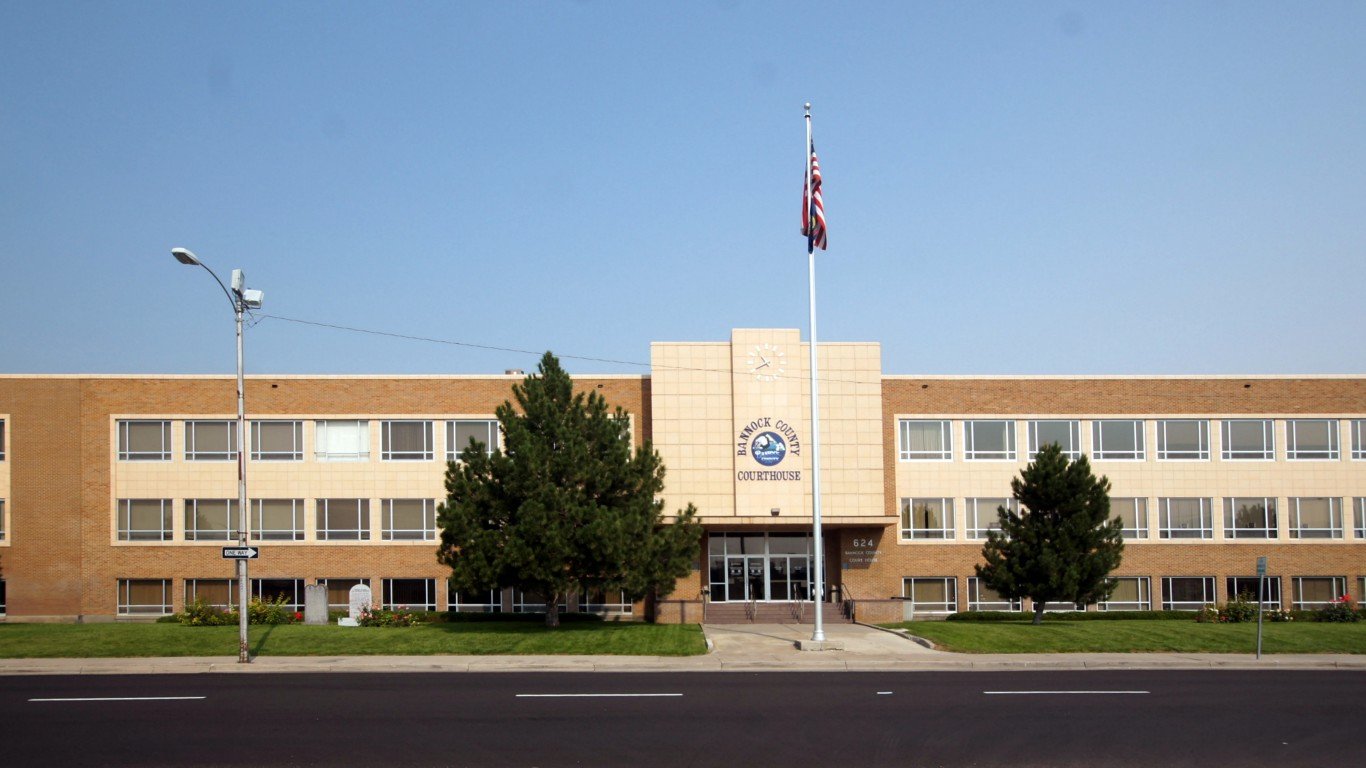
23. Pocatello, ID
> Fields that typically require a 4-yr. degree: 10.3% of all jobs (middle 50% of US metro areas)
> Avg. monthly wage, 22-24 yr. olds: $1,794 (bottom 10% of US metro areas)
> Oct. 2021 unemployment: 2.8% (top 25% of US metro areas)
> Adults with a bachelor’s degree or higher: 26.8% (middle 50% of US metro areas)
The Pocatello metro area in Idaho boasts a 2.8% unemployment rate, well below the 4.6% national jobless rate. However, beyond a strong job market, advantages for recent college graduates are limited. For example, the typical area worker with a bachelor’s degree earns just $38,912 a year — only $10,589 more than what the typical area worker with a high school diploma earns. Nationwide, the typical college educated worker earns nearly $55,000 annually, about $24,000 more than what the typical worker with a high school diploma earns.
Among all young workers in the metro area in the 22 to 24 age range, the average monthly wage is just $1,794, less than 90% of all U.S. metro areas.

22. New Orleans-Metairie, LA
> Fields that typically require a 4-yr. degree: 12.1% of all jobs (middle 50% of US metro areas)
> Avg. monthly wage, 22-24 yr. olds: $2,028 (middle 50% of US metro areas)
> Oct. 2021 unemployment: 5.6% (middle 50% of US metro areas)
> Adults with a bachelor’s degree or higher: 30.3% (middle 50% of US metro areas)
Recent college graduates often face hurdles when applying to jobs because of their lack of experience. Disadvantages for recent college graduates are even more profound in places with a weak job market to begin with. In the New Orleans metro area, unemployment was 5.6% as of October 2021, a full percentage point higher than the national jobless rate.
Employment opportunities for young adults in New Orleans have declined considerably during the pandemic. Employment among residents aged 22 to 24 has fallen by 12.7% between the first quarters of 2020 and 2021.
[in-text-ad-2]
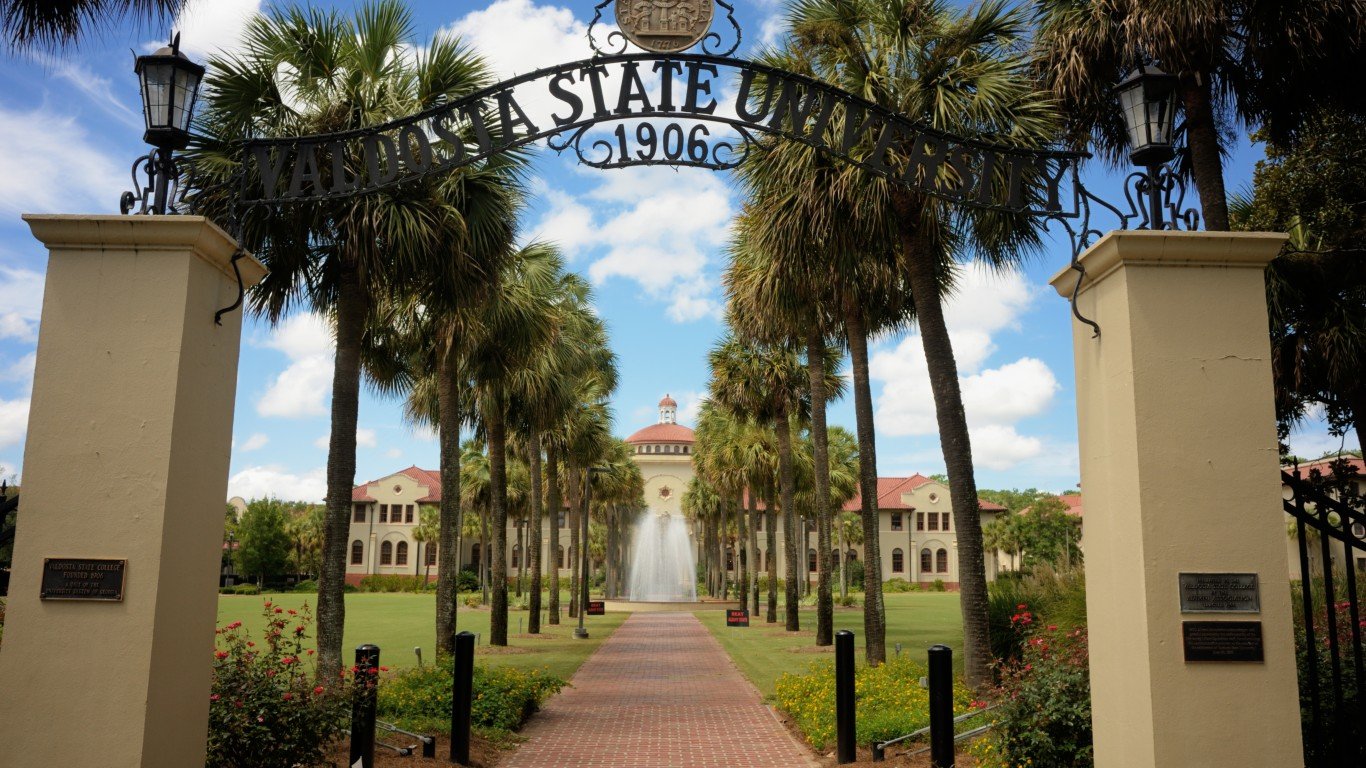
21. Valdosta, GA
> Fields that typically require a 4-yr. degree: 11.1% of all jobs (middle 50% of US metro areas)
> Avg. monthly wage, 22-24 yr. olds: $1,676 (bottom 10% of US metro areas)
> Oct. 2021 unemployment: 2.6% (top 25% of US metro areas)
> Adults with a bachelor’s degree or higher: 23.2% (middle 50% of US metro areas)
The Valdosta, Georgia, metro area has a relatively strong job market, with just 2.6% of the labor force out of work as of October 2021, 2 percentage points below the national jobless rate. However, many employment opportunities for young adults are not especially well paying. The average monthly wage among those in the 22 to 24 age group in the area is just $1,676, less than in over 90% of all U.S. metro areas.
Valdosta residents who have a college education are also far more likely to face poverty in their lifetime than those with a college degree nationwide. The local poverty rate among adults with a bachelor’s degree stands at 15.1%, compared to just 9.6% nationwide.

20. Muskegon, MI
> Fields that typically require a 4-yr. degree: 6.0% of all jobs (bottom 10% of US metro areas)
> Avg. monthly wage, 22-24 yr. olds: $1,986 (middle 50% of US metro areas)
> Oct. 2021 unemployment: 8.0% (bottom 10% of US metro areas)
> Adults with a bachelor’s degree or higher: 19.7% (bottom 25% of US metro areas)
The Muskegon, Michigan, metro area has relatively few employment opportunities that are typically suited for those with a bachelor’s or advanced degree. Only 6.0% of all jobs in the metro area are in the information, finance and insurance, professional, scientific, technical, and educational services sectors — a smaller share than in over 90% of all U.S. metro areas.
Recent college graduates entering the full-time labor force for the first time in the metro area face a competitive labor market with limited opportunities. Muskegon’s unemployment rate of 8.0% is well above the 4.6% national jobless rate.
[in-text-ad]
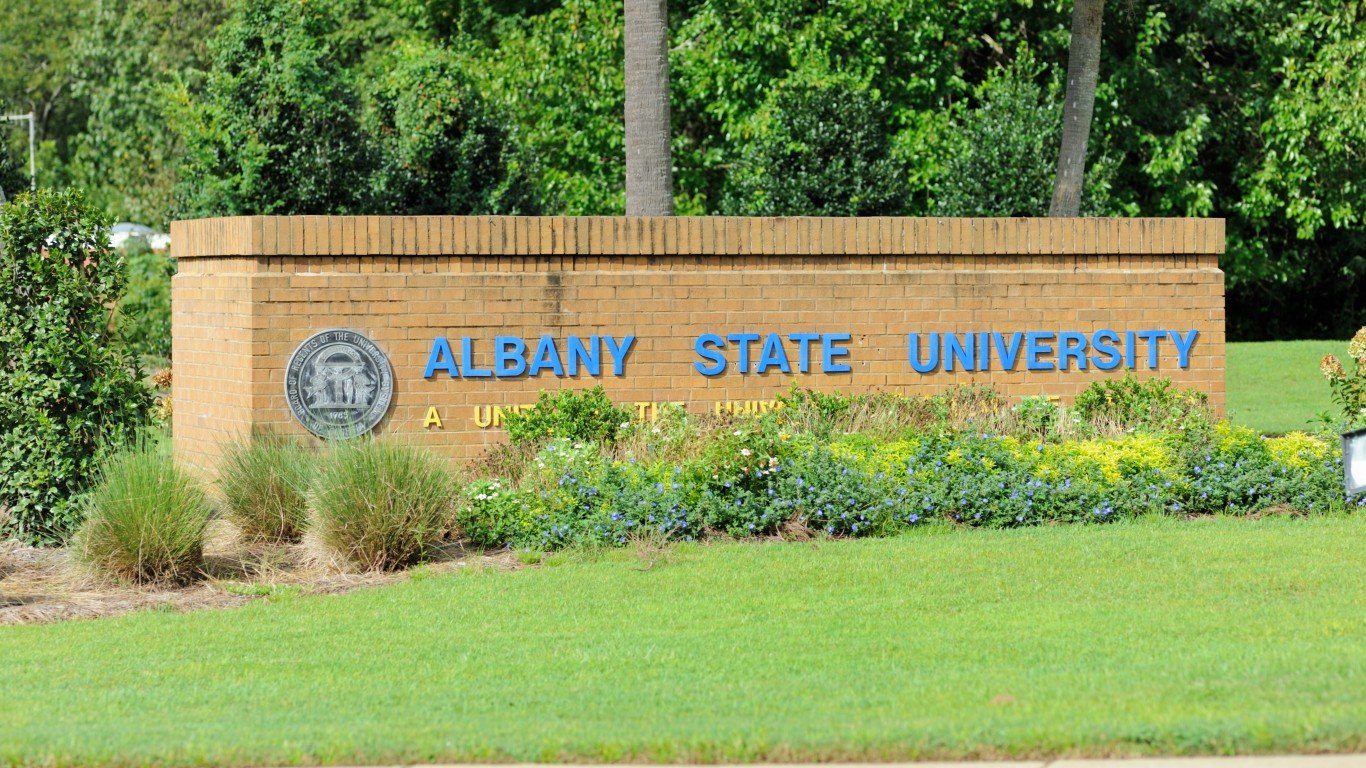
19. Albany, GA
> Fields that typically require a 4-yr. degree: 10.3% of all jobs (middle 50% of US metro areas)
> Avg. monthly wage, 22-24 yr. olds: $1,712 (bottom 10% of US metro areas)
> Oct. 2021 unemployment: 3.7% (middle 50% of US metro areas)
> Adults with a bachelor’s degree or higher: 20.0% (bottom 25% of US metro areas)
The Albany, Georgia, metro area offers few advantages for recent college graduates looking for work. For one, employment opportunities for young adults in the area are not especially well paying. The average monthly wage among those in the 22 to 24 age group in the area is just $1,712, less than in over 90% of all U.S. metro areas.
Nationwide, just under 10% of American adults with a college degree live below the poverty line. In the Albany metro area, financial security appears to be far more allusive for the college educated. The poverty rate among Albany residents 25 and older with a bachelor’s degree is 15.4%, higher than in all but a handful of other U.S. metro areas.
18. Pine Bluff, AR
> Fields that typically require a 4-yr. degree: 11.3% of all jobs (middle 50% of US metro areas)
> Avg. monthly wage, 22-24 yr. olds: $1,760 (bottom 10% of US metro areas)
> Oct. 2021 unemployment: 5.6% (middle 50% of US metro areas)
> Adults with a bachelor’s degree or higher: 16.5% (bottom 10% of US metro areas)
Pine Bluff is the only metro area in Arkansas to rank among the worst places for recent college graduates to find a job — partly because of limited earning potential for recent college grads. A college education does not confer as large a financial benefit in Pine Bluff as it does in much of the rest of the country. The typical college-educated worker in the metro area earns just $45,946 a year — only $16,222 more than what the typical area worker with a high school diploma earns. Meanwhile, nationwide, the typical college educated worker earns nearly $55,000 annually, about $24,000 more than what the typical worker with a high school diploma earns.
Newcomers to the labor force face the additional disadvantage as Pine Bluff has a relatively weak job market. The local unemployment rate was 5.6% as of October 2021, a full percentage point higher than the national jobless rate.

17. Lake Charles, LA
> Fields that typically require a 4-yr. degree: 8.5% of all jobs (bottom 25% of US metro areas)
> Avg. monthly wage, 22-24 yr. olds: $2,380 (top 25% of US metro areas)
> Oct. 2021 unemployment: 5.1% (middle 50% of US metro areas)
> Adults with a bachelor’s degree or higher: 21.9% (bottom 25% of US metro areas)
College graduates in the Lake Charles, Louisiana, metropolitan area have relatively limited employment opportunities in fields that typically require a college education. Only 8.5% of all jobs in the metro area are in the information, finance and insurance, professional, scientific, technical, and educational services sectors — less than in over 75% of all U.S. metro areas.
As is often the case in places with few jobs that traditionally require a bachelor’s degree, a college education does not confer as much of a financial advantage as it does to college graduates nationwide. The typical college-educated worker in the metro area earns just $47,939 a year — only $16,595 more than what the typical area worker with a high school diploma earns. Meanwhile, nationwide, the typical college-educated worker earns nearly $55,000 annually, about $24,000 more than what the typical worker with a high school diploma earns.
[in-text-ad-2]
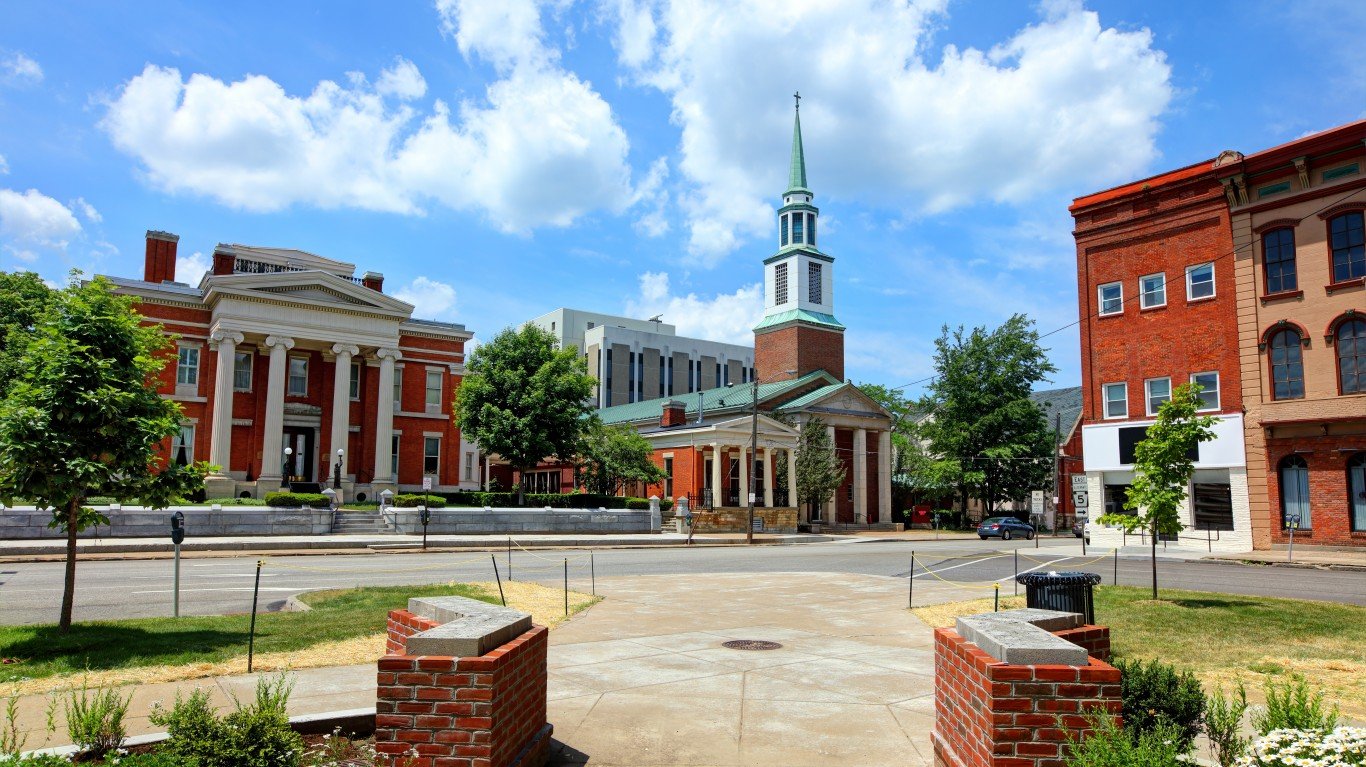
16. Erie, PA
> Fields that typically require a 4-yr. degree: 11.2% of all jobs (middle 50% of US metro areas)
> Avg. monthly wage, 22-24 yr. olds: $1,869 (bottom 25% of US metro areas)
> Oct. 2021 unemployment: 6.3% (bottom 25% of US metro areas)
> Adults with a bachelor’s degree or higher: 27.9% (middle 50% of US metro areas)
Erie is one of two Pennsylvania metro areas to rank among the worst places for recent college graduates to find a job. One disadvantage newcomers to the full-time labor force face in Erie is the prevalence of relatively low-paying jobs. Workers in the 22 to 24 age group earn an average of only $1,869 a month, less than in over 75% of all U.S. metro areas.
A college education also does not offer as much of a financial advantage as it does for college graduates nationwide. The typical college-educated worker in the metro area earns just $45,193 a year — only $15,155 more than what the typical area worker with a high school diploma earns. Meanwhile, nationwide, the typical college-educated worker earns nearly $55,000 annually, about $24,000 more than what the typical worker with a high school diploma earns.

15. Weirton-Steubenville, WV-OH
> Fields that typically require a 4-yr. degree: 11.1% of all jobs (middle 50% of US metro areas)
> Avg. monthly wage, 22-24 yr. olds: $1,952 (middle 50% of US metro areas)
> Oct. 2021 unemployment: 6.2% (bottom 25% of US metro areas)
> Adults with a bachelor’s degree or higher: 16.8% (bottom 10% of US metro areas)
The Weirton-Steubenville metro area, which covers parts of West Virginia and Ohio, ranks among the worst U.S. metro areas for college graduates beginning their careers. Earnings among college-educated workers in the metro area are low relative to earnings of college graduates nationwide. The typical area worker with a bachelor’s degree earns just $43,122 a year — only $14,361 more than what the typical area worker with a high school diploma earns. Nationwide, the typical college educated worker earns nearly $55,000 annually, about $24,000 more than what the typical worker with a high school diploma earns.
Relatively high unemployment in the area also means securing a job could be especially difficult for someone entering the full-time work force for the first time. An estimated 6.2% of the local labor force were unemployed in October 2021, compared to the national jobless rate of 4.6%.
[in-text-ad]
14. Grants Pass, OR
> Fields that typically require a 4-yr. degree: 7.1% of all jobs (bottom 10% of US metro areas)
> Avg. monthly wage, 22-24 yr. olds: $2,043 (middle 50% of US metro areas)
> Oct. 2021 unemployment: 5.5% (middle 50% of US metro areas)
> Adults with a bachelor’s degree or higher: 17.5% (bottom 10% of US metro areas)
Grants Pass, Oregon, is not an ideal place for recent college graduates to look for a job, largely because the types of jobs that typically require a college degree are not especially common in the metro area. Only 7.1% of area jobs are in sectors that traditionally require a bachelor’s degree — like information, finance and insurance, professional, scientific, and technical services — a smaller share than in over 90% of all U.S. metro areas.
College-educated adults in Grants Pass are also far more likely to struggle financially than college-educated workers nationwide. The typical college-educated worker in the metro area earns about $40,500 annually and 15.5% of college educated residents live below the poverty line. Meanwhile, the median earnings among college graduates nationwide is about $55,000 and less than 10% of college graduates nationwide live below the poverty line.
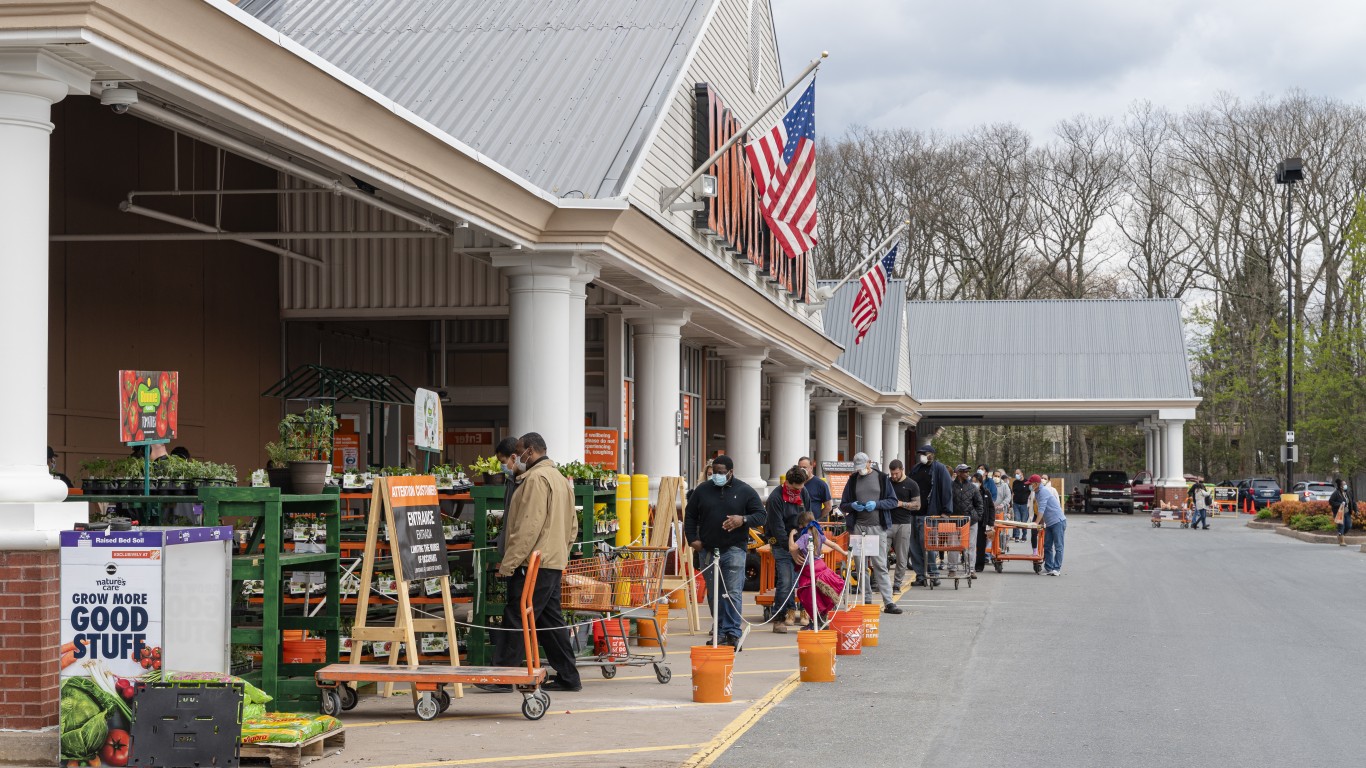
13. East Stroudsburg, PA
> Fields that typically require a 4-yr. degree: 5.6% of all jobs (bottom 10% of US metro areas)
> Avg. monthly wage, 22-24 yr. olds: $1,894 (bottom 25% of US metro areas)
> Oct. 2021 unemployment: 6.9% (bottom 10% of US metro areas)
> Adults with a bachelor’s degree or higher: 24.7% (middle 50% of US metro areas)
The labor market in the East Stroudsburg, Pennsylvania, metro area has relatively few employment opportunities in fields that traditionally require a college degree. Only 5.6% of area jobs are in sectors such as information, finance and insurance, professional, scientific, and technical services — a smaller share than in over 90% of all U.S. metro areas.
Not only are jobs geared toward college graduates scarce in East Stroudsburg, but also the local job market in general is struggling. The local unemployment rate in the metro area as of October 2021 was 6.9%, well above the 4.6% national jobless rate.

12. Kingston, NY
> Fields that typically require a 4-yr. degree: 11.5% of all jobs (middle 50% of US metro areas)
> Avg. monthly wage, 22-24 yr. olds: $1,998 (middle 50% of US metro areas)
> Oct. 2021 unemployment: 4.8% (middle 50% of US metro areas)
> Adults with a bachelor’s degree or higher: 32.5% (middle 50% of US metro areas)
Kingston is the only metro area in New York state to rank among the worst metropolitan areas for recent college graduates to start their career. One reason is that a college education does not confer as much of a financial benefit as it does overall nationwide. The typical college-educated worker in the metro area earns just $50,192 a year — only $17,567 more than what the typical area worker with a high school diploma earns. Meanwhile, nationwide, the typical college-educated worker earns nearly $55,000 annually, about $24,000 more than what the typical worker with a high school diploma earns.
Nationwide, just under 9.6% of American adults with a college degree live below the poverty line. In the Kingston metro area, financial security appears to be more elusive for the college educated. The poverty rate among Kingston residents 25 and older with a bachelor’s degree is 11.4%.
[in-text-ad-2]

11. Flint, MI
> Fields that typically require a 4-yr. degree: 9.5% of all jobs (middle 50% of US metro areas)
> Avg. monthly wage, 22-24 yr. olds: $1,946 (bottom 25% of US metro areas)
> Oct. 2021 unemployment: 8.5% (bottom 10% of US metro areas)
> Adults with a bachelor’s degree or higher: 21.2% (bottom 25% of US metro areas)
Flint, Michigan, does not offer recent college graduates many career advantages. The October 2021 unemployment rate in Flint of 8.5% is among the highest of any U.S. metro area and well above the 4.6% national jobless rate.
For younger workers in the metro area who are able to find a job, incomes are generally low. The average monthly wage among workers in the 22 to 24 age range in Flint is just $1,946, less than in about 75% of all U.S. metro areas.

10. Youngstown-Warren-Boardman, OH-PA
> Fields that typically require a 4-yr. degree: 8.3% of all jobs (bottom 25% of US metro areas)
> Avg. monthly wage, 22-24 yr. olds: $1,767 (bottom 10% of US metro areas)
> Oct. 2021 unemployment: 6.6% (bottom 25% of US metro areas)
> Adults with a bachelor’s degree or higher: 21.9% (bottom 25% of US metro areas)
By several key measures, the Youngstown-Warren-Boardman metro area, which covers parts of Ohio and Pennsylvania, is not an ideal place for a college graduate to find work. Only 8.3% of area jobs are in sectors that traditionally require a bachelor’s degree — like information, finance and insurance, professional, scientific, and technical services — a smaller share than in over 75% of all U.S. metro areas.
The area also has a 6.6% jobless rate, well above the 4.6% U.S. unemployment rate. And for younger workers in the metro area who are able to find a job, incomes are generally low. The average monthly wage among workers in the 22 to 24 age range in the area is just $1,767, less than in about 90% of all U.S. metro areas.
[in-text-ad]

9. Fayetteville, NC
> Fields that typically require a 4-yr. degree: 10.4% of all jobs (middle 50% of US metro areas)
> Avg. monthly wage, 22-24 yr. olds: $1,776 (bottom 10% of US metro areas)
> Oct. 2021 unemployment: 6.0% (bottom 25% of US metro areas)
> Adults with a bachelor’s degree or higher: 23.7% (middle 50% of US metro areas)
The Fayetteville metro area in North Carolina ranks among the worst places for recent college graduates to find a job — in part because of lower than average pay for those in the age range of a typical college graduate. Among workers between the ages of 22 and 24 in the metro area, the average monthly wage is just $1,776, less than in about 90% of all U.S. metro areas.
Additionally, the typical college-educated worker in the metro area earns just $44,386 a year — only $17,591 more than what the typical area worker with a high school diploma earns. Meanwhile, nationwide, the typical college educated worker earns nearly $55,000 annually, about $24,000 more than what the typical worker with a high school diploma earns.

8. Beckley, WV
> Fields that typically require a 4-yr. degree: 8.2% of all jobs (bottom 25% of US metro areas)
> Avg. monthly wage, 22-24 yr. olds: $1,936 (bottom 25% of US metro areas)
> Oct. 2021 unemployment: 4.7% (middle 50% of US metro areas)
> Adults with a bachelor’s degree or higher: 17.1% (bottom 10% of US metro areas)
Beckley, West Virginia, is not an ideal place for recent college graduates to look for a job, largely because the types of jobs that typically require a college degree are not especially common in the metro area. Only 8.2% of area jobs are in sectors that traditionally require a bachelor’s degree — like information, finance and insurance, professional, scientific, and technical services — a smaller share than in over 75% of all U.S. metro areas.
Earnings among college-educated workers in the metro area are also low relative to earnings of college graduates nationwide. The typical area worker with a bachelor’s degree earns just $42,146 a year — only $15,579 more than what the typical area worker with a high school diploma earns. Nationwide, the typical college educated worker earns nearly $55,000 annually, about $24,000 more than what the typical worker with a high school diploma earns.

7. Gulfport-Biloxi-Pascagoula, MS
> Fields that typically require a 4-yr. degree: 8.9% of all jobs (bottom 25% of US metro areas)
> Avg. monthly wage, 22-24 yr. olds: $1,699 (bottom 10% of US metro areas)
> Oct. 2021 unemployment: 5.6% (middle 50% of US metro areas)
> Adults with a bachelor’s degree or higher: 21.9% (bottom 25% of US metro areas)
Mississippi’s Gulfport-Biloxi-Pascagoula metro area has relatively little to offer recent college graduates beginning their career. Only 8.9% of area jobs are in sectors that typically require a college education — like information, finance and insurance, professional, scientific, and technical services — a smaller share than in over 75% of all U.S. metro areas.
Young workers in the metro area are also unlikely to have high salaries that might be necessary to pay down student loans from an undergraduate degree. Among those in the 22 to 24 age range in the metro area, the average monthly wage is just $1,699, less than in over 90% of all U.S. metro areas.
[in-text-ad-2]

6. Farmington, NM
> Fields that typically require a 4-yr. degree: 9.6% of all jobs (middle 50% of US metro areas)
> Avg. monthly wage, 22-24 yr. olds: $1,838 (bottom 25% of US metro areas)
> Oct. 2021 unemployment: 7.6% (bottom 10% of US metro areas)
> Adults with a bachelor’s degree or higher: 14.9% (bottom 10% of US metro areas)
Farmington is one of two metro areas in New Mexico to rank among the worst places for recent college graduates to look for a job. One reason is limited job availability. As of October 2021, unemployment in the metro area was 7.6%, 3 percentage points higher than the 4.6% national jobless rate.
Nationwide, just under 9.6% of American adults with a college degree live below the poverty line. In the Farmington metro area, financial security appears to be more elusive for the college educated. The poverty rate among Farmington residents 25 and older with a bachelor’s degree is 13.4%.

5. Santa Fe, NM
> Fields that typically require a 4-yr. degree: 12.4% of all jobs (middle 50% of US metro areas)
> Avg. monthly wage, 22-24 yr. olds: $2,033 (middle 50% of US metro areas)
> Oct. 2021 unemployment: 5.6% (middle 50% of US metro areas)
> Adults with a bachelor’s degree or higher: 41.0% (top 10% of US metro areas)
Santa Fe is the worst metro area in New Mexico for recent college graduates to find a job — partly because of limited earning potential for recent college grads. A college education does not confer as large a financial benefit in Santa Fe as it does nationwide. The typical college-educated worker in the metro area earns just $45,338 a year — only $15,627 more than what the typical area worker with a high school diploma earns. Meanwhile, nationwide, the typical college educated worker earns nearly $55,000 annually, about $24,000 more than what the typical worker with a high school diploma earns.
Employment opportunities for young adults in Santa Fe have declined considerably during the pandemic. Employment among residents aged 22 to 24 has fallen by 14.7% between the first quarters of 2020 and 2021.
[in-text-ad]
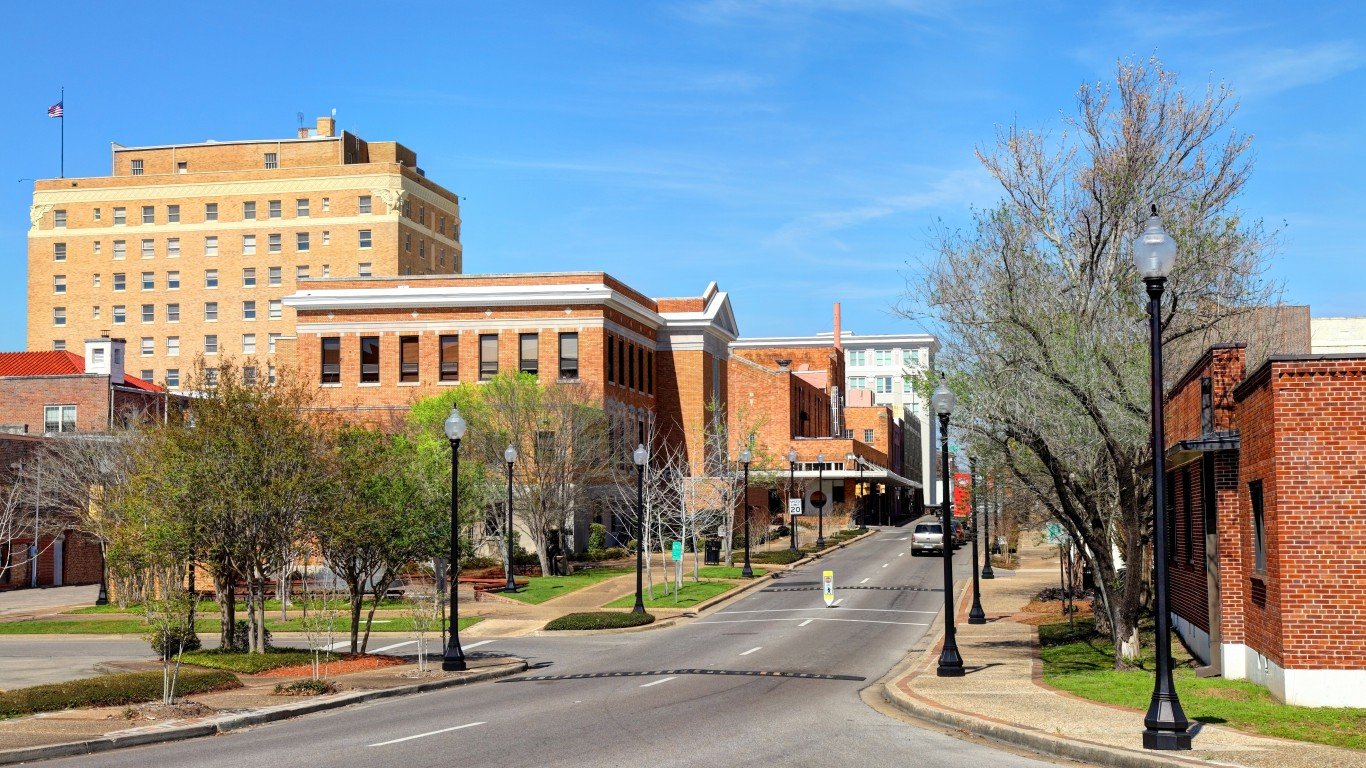
4. Hattiesburg, MS
> Fields that typically require a 4-yr. degree: 7.9% of all jobs (bottom 10% of US metro areas)
> Avg. monthly wage, 22-24 yr. olds: $1,520 (bottom 10% of US metro areas)
> Oct. 2021 unemployment: 4.7% (middle 50% of US metro areas)
> Adults with a bachelor’s degree or higher: 27.4% (middle 50% of US metro areas)
Mississippi’s Hattiesburg metro area has relatively little to offer recent college graduates beginning their career. Only 7.9% of area jobs are in sectors that typically require a college education — like information, finance and insurance, professional, scientific, and technical services — a smaller share than in over 90% of all U.S. metro areas.
Young workers in the metro area are also unlikely to have high salaries that might be necessary to pay down student loans from an undergraduate degree. Among those in the 22 to 24 age range in the metro area, the average monthly wage is just $1,520, less than in all but a handful of U.S. metro areas.

3. Kahului-Wailuku-Lahaina, HI
> Fields that typically require a 4-yr. degree: 5.1% of all jobs (bottom 10% of US metro areas)
> Avg. monthly wage, 22-24 yr. olds: $2,261 (top 25% of US metro areas)
> Oct. 2021 unemployment: 8.4% (bottom 10% of US metro areas)
> Adults with a bachelor’s degree or higher: 27.2% (middle 50% of US metro areas)
Kahului-Wailuku-Lahaina is one of the worst places for recent college graduates to look for a job. One reason is limited job availability. As of October 2021, unemployment in the metro area was 8.4%, well above the 4.6% national jobless rate.
The area’s high unemployment likely only increases already tight competition for the relatively few job opportunities in fields that traditionally require applicants to have at least a bachelor’s degree. Only 5.1% of area jobs are in sectors that typically require a college education — like information, finance and insurance, professional, scientific, and technical services — a smaller share than in all but a handful of U.S. metro areas.

2. Yuma, AZ
> Fields that typically require a 4-yr. degree: 10.5% of all jobs (middle 50% of US metro areas)
> Avg. monthly wage, 22-24 yr. olds: $1,994 (middle 50% of US metro areas)
> Oct. 2021 unemployment: 13.7% (bottom 10% of US metro areas)
> Adults with a bachelor’s degree or higher: 15.0% (bottom 10% of US metro areas)
Yuma, Arizona, ranks among the worst metro areas in the country for recent college graduates to find a job, largely due to its weak job market. Unemployment in Yuma was 13.7% in October 2021, nearly the highest of any U.S. metro area and nearly triple the national jobless rate of 4.6%.
For college graduates who are able to find a job in the Yuma metro area, the financial advantage their degree gives them is not as great as it is in other parts of the country. The typical college-educated worker in the metro area earns just $41,595 a year — only $13,644 more than what the typical area worker with a high school diploma earns. Meanwhile, nationwide, the typical college educated worker earns nearly $55,000 annually, about $24,000 more than what the typical worker with a high school diploma earns.
[in-text-ad-2]

1. El Centro, CA
> Fields that typically require a 4-yr. degree: 7.1% of all jobs (bottom 10% of US metro areas)
> Avg. monthly wage, 22-24 yr. olds: $1,828 (bottom 25% of US metro areas)
> Oct. 2021 unemployment: 16.6% (bottom 10% of US metro areas)
> Adults with a bachelor’s degree or higher: 15.2% (bottom 10% of US metro areas)
El Centro, California, ranks as the worst metro area in the country for recent college graduates to find a job, largely due to its weak job market. Unemployment in El Centro was 16.6% in October 2021, the highest of any U.S. metro area and more than triple the national jobless rate of 4.6%.
College-educated adults in El Centro are also more likely to struggle financially than college-educated workers in much of the rest of the country. The typical college educated worker in the metro area earns about $43,476 annually, and 13.7% of college-educated residents live below the poverty line. Meanwhile, the median earnings among college graduates nationwide is about $55,000 and only 9.6% of college graduates nationwide live below the poverty line.
Methodology
To determine the worst cities to find a job for recent graduates, 24/7 Wall St. developed an index of six measures, analyzing job growth, earnings, and employment for young, college-educated graduates in cities nationwide. Only metropolitan areas where 35% or less of the population 3 years and over are enrolled in college or graduate school were considered in our analysis.
The first measure, average monthly earnings for 22-24-year-olds in the first quarter of 2021, came from the Bureau of Labor Statistics’ Quarterly Workforce Indicators extraction tool and was included in the index at full weight.
The second measure, the percentage change in employment of 22-24-year-olds from Q1 2020 to Q1 2021, was calculated using data from the QWI and was included in the index at full weight.
The third measure included data on the percentage of 22-24-year-olds employed in information, finance and insurance, professional, scientific, and technical services, and educational services — professions that typically require a college education — and was calculated using data from the QWI and was included in the index at full weight.
The fourth measure, seasonally-adjusted data on the unemployment rate as of October 2021, came from the BLS Local Area Unemployment Statistics program and was included in the index at full weight.
The fifth measure, the ratio of median earnings for adults 25 years and over with a bachelor’s degree to the median earnings for adults 25 years and over of all education levels, was calculated using five-year data from the U.S. Census Bureau’s 2019 American Community Survey and was included in the index at full weight.
The sixth measure, the percentage of adults 25 years and over with a bachelor’s degree or higher living at or below the poverty line, came from the 2019 ACS and was included in the index at full weight.
Sponsored: Attention Savvy Investors: Speak to 3 Financial Experts – FREE
Ever wanted an extra set of eyes on an investment you’re considering? Now you can speak with up to 3 financial experts in your area for FREE. By simply
clicking here you can begin to match with financial professionals who can help guide you through the financial decisions you’re making. And the best part? The first conversation with them is free.
Click here to match with up to 3 financial pros who would be excited to help you make financial decisions.
Thank you for reading! Have some feedback for us?
Contact the 24/7 Wall St. editorial team.
 24/7 Wall St.
24/7 Wall St.
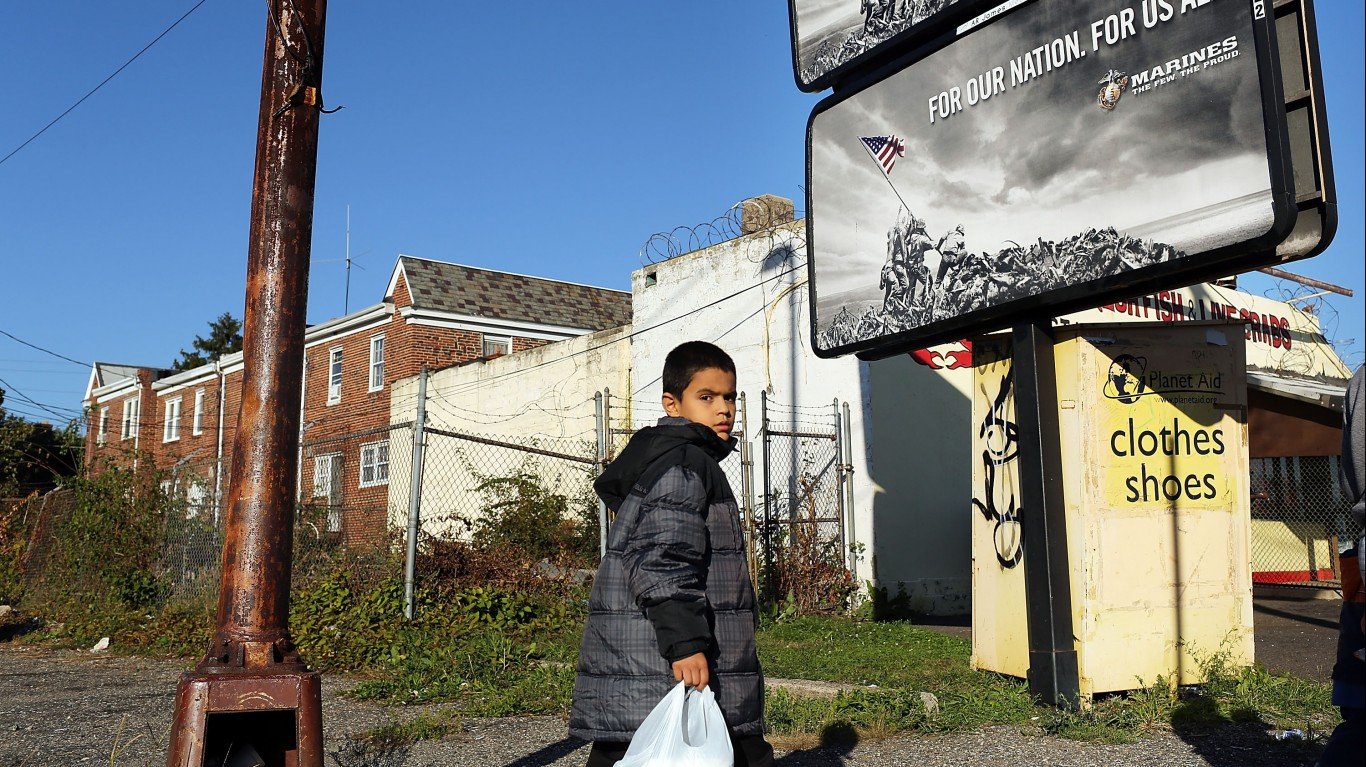 24/7 Wall St.
24/7 Wall St.